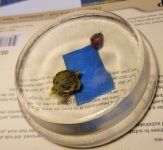Greg Kimsey
Well-known member
My elderly friend, Bob, purchased this kit from me saying he wanted to try to build it. His Parkinsons was so bad that I say no way that could happen. It didn't. He brought it back and asked if I would build it. I always say yes. He is such a lonely old man.So I have taken a short break from my Israeli F-16 to do Bob a solid.
His requests were
Body- White
Interior- Teal
Hood detached.
Convertible.
Custom version, not stock
I am trying to make this as clean as I can (no glue fingerprints, smudges, etc). This might be the cleanest engine I have ever done.



I have always tried to make the sparkplug boots from one piece and cut a V at the bend, bend it and superglue. It has never worked out satisfactorily. This time I cut the boot into two tiny pieces with a 90 on one end and a 45 on the other, then slide the pieces onto the wire so the 45's meet to form a 90 degree boot. I gotta say, it worked out so well that I hate it took 50 years to try it.
I have all of the other parts primed for painting. More to come later!
His requests were
Body- White
Interior- Teal
Hood detached.
Convertible.
Custom version, not stock
I am trying to make this as clean as I can (no glue fingerprints, smudges, etc). This might be the cleanest engine I have ever done.
I have always tried to make the sparkplug boots from one piece and cut a V at the bend, bend it and superglue. It has never worked out satisfactorily. This time I cut the boot into two tiny pieces with a 90 on one end and a 45 on the other, then slide the pieces onto the wire so the 45's meet to form a 90 degree boot. I gotta say, it worked out so well that I hate it took 50 years to try it.
I have all of the other parts primed for painting. More to come later!





